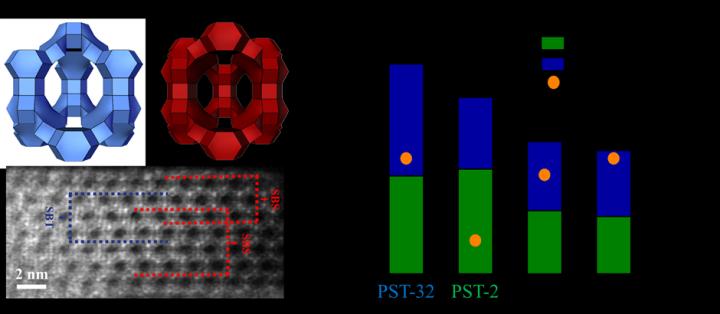
Credit: POSTECH
A research team at POSTECH has uncovered a promising new zeolite, anticipated to be a turning point for the oil refining and petrochemical industries. This research was recently published in the scientific journal Science on July 2, 2021.
The team of researchers led by Suk Bong Hong, a professor in the Division of Environmental Science and Engineering at POSTECH, synthesized two thermally stable three-dimensional (3D) large-pore (12-ring)1 zeolites – PST-32 (POSTECH No. 32) and PST-2, the hypothetical SBS/SBT intergrowth structure2 – by using the “multiple inorganic cation” and the “charge density mismatch” synthetic strategies, respectively. The research team identified their structures by using both powder X-ray diffraction data at the Pohang Accelerator Lab and electron microscopy analysis measured at the Instituto de Nanociencia y Materiales de Aragon (INMA). This study was co-first authored by Dr. Hwajun Lee of POSTECH and Dr. Jiho Shin of the Petrochemical Catalyst Research Center of the Korea Research Institute of Chemical Technology.
Zeolites are crystalline microporous aluminosilicates materials with well-characterized and uniform pore structures that offer a wide range of commercial applications in catalysis and separation because of their structural and chemical stability. In particular, zeolite Y, which has a cage-based large-pore (12-ring) structure, is an indispensable catalyst in the oil refining and petrochemical processes that produce numerous kinds of chemical products from crude oil. Currently, about 40% of the world’s crude oil production is made into products essential for our daily life – like gasoline – by zeolite Y-based catalysts.
The newly developed PST-32 and PST-2 are structurally similar to zeolite Y but consist of super-cages of different shapes and sizes and have excellent thermal stability. It was also confirmed that these zeolites exhibit higher catalytic activity than zeolite Y in the reaction to produce the chemicals ethylene and propylene, which are basic raw materials obtained by decomposing diesel, which is losing value as a fuel source.
“Considering the fact that zeolite Y-based catalysts account for 10% of the global catalyst market, which is more than 10 billion USD, Science seems to have deemed PST-32 and PST-2 as game changers that can disrupt the catalyst market, in addition to their scholarly significance,” remarked Professor Suk Bong Hong who led the study.
This work was supported by the National Creative Research Initiative Program (2012R1A3A2048833) through the National Research Foundation.
###
Media Contact
Jinyoung Huh
[email protected]
Original Source
https:/
Related Journal Article
http://dx.




